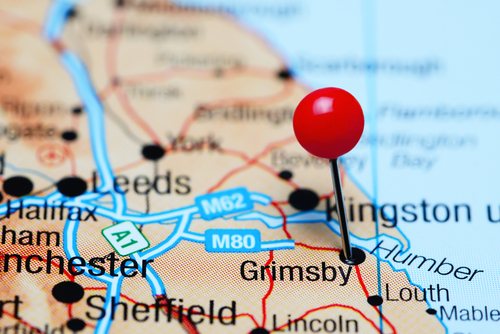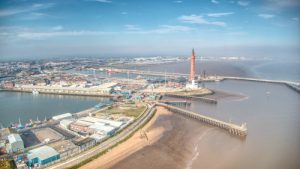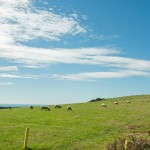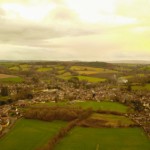
Grimsby, properly known as Great Grimsby, is a town, seaport and unitary authority, which along with Cleethorpes, forms the North Lincolnshire conurbation. The town is situated on the east coast of England, just south of the Humber Estuary, about 6 miles (10 km) west of the North Sea, 17 miles (27 km) south of Hull, and 28 miles (45 km) east of Scunthorpe. An internationally renowned fishing port, up until the middle of the 20th century it was recognised as being home to the world’s largest trawler fleet.
A Fleeting Grimsby History
There is archaeological evidence to suggest that there was an early 2nd-century small Roman settlement situated in the Grimsby area. It’s been theorised that it was established by workers involved in the salt panning industry. However, it is the invading Viking Danes, who reputedly first arrived on British shores on the southern bank of the Humber at the end of the 9th century, that are generally credited with establishing the town.
In fact, according to Norse mythology, as narrated in the poetic tale of 1170, ‘The Lay of Havelok the Dane’, it was the Danish fisherman ‘Grim’, who was the founding father of Grimsby.
The story alleges that Grim decided to settle in the area because of the mariner’s natural ‘haven’ that point on the Humber estuary provided. Thus, at ‘Haven’s lock’ he established the ‘village of Grim’. As news of Grim’s settlement spread throughout Denmark, more Vikings were tempted to make the crossing of the North Sea for a new life in ‘Danelaw’. The new arrivals integrated well with the existing community, passing on their fishing and trading skills.
Thus, the village of Grim quickly grew to become a thriving fishing port and commercial centre, which saw it trading across England, and as far away as France and Flanders. And, while the tale obviously belongs to folklore, it does more than touch on real events.
The Doomsday Book Lists Grimsby
In the Norman Domesday Book of 1086, it’s recorded that Grimsby and the adjoining lands, were in the possession of Ralf de Mortimer. The population in and around Grimsby at that time has been estimated at about 200.
During the 12th century, Grimsby continued to develop as a fishing and commercial port. Timber was being imported from Norway, wine from France and Spain, and coal from Newcastle, while wool was being exported.
In 1132, Grimsby saw the founding of an Augustinian Abbey, and in 1184, St Leonard’s nunnery. The 12th century also saw two parish churches founded in the town, St Mary’s and St James’, although only the latter, now known as Grimsby Minster, survives.
In 1201, the town saw a charter granted by King John, and a year later, the first mayor installed. In 1240, Franciscan monks established an abbey in the town, and 1293, saw the Austin friars follow suit. By this time the population of Grimsby had grown to some 1,500, a fair-sized town of the time.
Haven No More
By the mid-15th century, The Haven had begun to silt up, preventing ships from entering and docking from the Humber. This resulted in Grimsby entering into a long period of steady decline which would last for well over three centuries.
Though the 16th and 17th centuries Grimsby’s population continued to diminish, though it’s the import of coal and export grain continued to grow. In 1556, the wooden bridge over the Haven was replaced with a more permanent stone structure.
By 1539, Grimsby’s four main religious establishments, i.e. the Augustinian, Franciscan and Austin abbey’s and it’s nunnery had been closed down under Henry VIII’s Dissolution of the Monasteries Act. The town did not see any signs of revival until the late 18th century when in 1780, a new town hall was built.
In 1796, the Grimsby Haven Act was passed by Parliament for the purpose of “widening, deepening, enlarging, altering and improving the Haven of the Town and Port of Great Grimsby”. In 1801, the time of the first national census, Grimsby’s population was recorded as 1,524, about the same that it had been some 500 years earlier.
After improvements to ‘The Haven’ were complete, the early 19th century saw the town grow rapidly as the fortunes of its port were revived. Grimsby began to boom once again, with its main imports being iron, timber, wheat, hemp and flax. The 1845 Grimsby Docks Act saw work begin on the much-needed expansion of the dockland area.
The Railway Arrives
In 1848, the arrival of the railway made it much easier and quicker to transport goods between the port and the rest of the country. Notably, coal mined in the South Yorkshire could now be readily exported through Grimsby, while fish landed at the port could reach London’s Billingsgate Fish Market within a matter of hours.
In 1851, improvements to the dockland facilities saw the Dock Tower being completed. In 1852, the Royal Dock was opened. In 1856, the county’s first dedicated fish dock was opened at Grimsby. This was followed by the opening of a second fish dock in 1877. Alexandra Dock and Union Dock were both completed in 1879.
During this period, Grimsby’s fishing fleet greatly expanded which saw a large migration of fishermen from the South of England to the town. While in 1857, the town’s fishing fleet had numbered 22 vessels, within 6 years that number had grown to 112. The town also saw the country’s first-ever viable steam-powered trawler operating from the port.
In 1881, the town saw horse-drawn trams running in the streets for the first time. Grimsby also saw its facilities improve, when Peoples Park opened in 1883, the Duke of York Gardens in 1894, and the first public library in 1900. In 1901, Grimsby gained electric street lighting, while its horse-drawn trams were replaced with the new electric version. Fishermen’s Chapel was built in 1904, while Corporation Bridge opened in 1928.
20th Century Grimsby
By 1900, ten per cent of all the fish consumed in the UK were being landed at Grimsby. By 1901, the population of Grimsby had swelled to more than 75,000, and by 1931 it had reached 92,000. The 1930s ‘Great Depression’ saw a major restructuring of the town’s industries and a subsequent decline in employment. However, the town’s population remained fairly stable at its 1930’s levels throughout the rest of the 20th century.
In 1937, as had already happened in much of the country, the town’s electric trams were replaced with regular buses. During World War II, Grimsby fell victim to a good many bombings, with a total of 197 people being killed. However, despite the war years, Grimsby’s fishing industry continued to grow. It peaked in the mid-1950s when the town could lay claim to the title of being the ‘largest fishing port in the world’.
However, in 1958, Britain engaged in its first ‘Cod War’, which culminated in Iceland extending its exclusive coastal fishing zone from 4 miles to 12 miles, from shore. The event was enough to tip Grimsby’s fishing industry into a sustained long steady decline.
The Modern Era
By the early 1970s, Grimsby’s fishing industry was supporting 6,000 sea-going fishermen and a further 40,000 land-based jobs. However, a second Cod War in 1972/73, and third in 1975/76, concluded in the already-declining British fisheries being further excluded from their historical prime fishing grounds. The UK’s large northern fishing ports such as Grimsby were most severely affected with thousands of jobs being lost in the industry.
However, despite Grimsby’s economic decline, there were still some major developments in town during the latter part of the 20th century. These included the building of the Abbeygate Shopping Centre in 1984; the Freshney Shopping Centre in 1989; and the National Fishing Heritage Centre in 1991.
Today, Grimsby’s main sectors of the economy are; food and drink production, ports and logistics, renewable energy, the chemical industry and digital media. It’s still also recognised as one of the UK’s chief fishing ports and as the main centre for the country’s fish processing industry, including frozen and chilled related foods. At the 2011 national census, the town had a recorded population of 88,243.
Travelling To Grimsby
By Road
From the south, you should leave the A1 at Newark and then follow the A46 all the way to Grimsby. Alternatively, from the M1, take the M18 and head north past Doncaster to the M180. Then head eastwards passing Scunthorpe and the Humber Bridge until you reach the A180, which takes you into Grimsby. From the north, join the M62 and head east to the M18. Journey south on the M81 until you reach the M180, then follow as mentioned above.
By Train
Grimsby train station is the penultimate stop on the Sheffield-Cleethorpes Line, which is 3 miles away. East Midlands Trains operate a service on the Newark-Grimsby route and TransPennine Express operate on the South Humberside Main Line. The latter operates an hourly service to/from Manchester Piccadilly. The other lines operate a 2 hourly daily service but there’s a reduced service to/from Manchester on Sundays.
By Bus
National Express coach services run daily from London Victoria to Grimsby & Cleethorpes, en-route to Hull. There are also daily services from Cornwall, via Taunton, Bristol, Birmingham, Leicester and Newark,
By Air
Humberside Airport is 12 miles (19 km) west of Grimsby but has very few scheduled flights. A shuttle bus service operates between Grimsby and the Airport. Manchester International Airport is 127 miles from Grimsby but well connected by train (see above). The average journey time is about 3 hours, changing at Manchester Piccadilly
Things to see and do
Some of the recommended things to see and do in and around Grimsby are:
- Grimsby Fishing Heritage Centre – is a museum that is themed around the history of the local fishing industry. There are also interactive displays, which where possible use fittings and fixtures from old trawlers. It’s located at Alexandra Dock.
- Grimsby Dock Tower – is one of the town’s most iconic landmarks buildings. Built-in 1852 to generate hydraulics for dockyard operations, the 94 m high Gothic Revival tower is a Grade I-listed structure. It’s only open to the public on special days throughout the year.
- Time Trap Museum – is housed at the Town Hall. You can take a tour of the old police cells and there’s also displays and exhibitions which tell the story of Grimsby’s turbulent past.
- Corporation Bridge – is a ‘bascule’ or lifting bridge, built-in 1925. It spans the entrance to Alexandra Docks but nowadays is largely inactive, though lifted on occasions for testing and maintenance purposes.
- Cleethorpes Beach – is 4.5 miles of flat, broad sands, that is backed by a promenade. You’ll find all the usual fun seaside things there, such as donkey rides, paddle boarding, amusement arcades, etc. The beach is located about 3 miles from Grimsby.
- Grimsby Minster – is a Church of England minster and parish church dedicated to St James. Whilst the central tower is Medieval, most of the church structure and interior is Victorian. However, there are also relics in the interior that date from the 13th and 14th centuries.
- Waltham Windmill – was built in 1880, and is a six-sailed, brick-built, still working windmill – one of a few of such type in the UK. There’s also a museum dedicated to local rural life. The mill is open to the public at weekends from Easter to September and daily in school holidays, 10 am – 4 pm. It’s situated 5 miles south of Grimsby.
- Grimsby Auditorium – was built in 1995 and is one of the largest music and theatre venues in the East of England. It has a capacity of up to 2000 and stages a diverse range of shows, including ballet, opera, stand-up comedy and musicals.
- Grimsby Leisure Centre – is a venue where you could easily spend the day as it has a swimming pool, an ice rink and various gym and fitness facilities.

Grimsby docklands with its imposing Dock Tower Image Peter Yeo/Shutterstock.com
Sport In Grimsby
Football
Grimsby Town FC, nicknamed “The Mariners” are the local team, although despite their name they don’t play here! The clubs home stadium Blundell Park is actually in nearby Cleethorpes but hey it’s close enough and sports the town name. They currently (2020) play in the English League Division 2, the fourth tier of English football.
Rugby
Grimsby RUFC currently plays their rugby in the Midlands 3 East (North) Division. They play their homes games at Springfield.
Notable Grimsby People
A few notable people who were born in, or have a connection to, Grimsby, include:
- Walter Bertram Wood (1898 – 1917) – was a Lieutenant in the British Army and World War I flying ace who has been credited with 13 confirmed aerial victories. A recipient of the Military Cross he was killed in action in November 1917. He was born and lived in Grimsby until he enlisted in the Army in 1916.
- Guy Martin – is a motorcycle racer and tv personality who specialising in presenting programmes with a mechanical engineering-based theme. In recent times he as also become a successful author. He was born in Grimsby on 4 November 1981.
- Freddie Frinton (1909 – 1968) – was a renowned actor and comedian of his day, who became hugely popular throughout Western Europe and Scandinavia. He was born Frederick Bittiner Coo in Hainton Avenue, Grimsby on 17th January 1909.
- John Hurt (1940 – 2017 ) – was a world-renowned stage, tv and film actor, whose career spanned more than 50 years. He lived in Cleethorpes as a teen and attended Grimsby Art School (now the East Coast School of Art and Design) during the late 1950s.

Guy Martin – local celebrity and TV personality Alexander-Glover/Shutterstock.com
Did you know?
- Grimsby is still the UK’s largest fishing port and holds the country’s largest fish market.
- People from Grimsby are locally known as Grimbarians, but a little more mockingly are sometimes referred to as ”codheads”, especially the town’s football fans.
- In 1998, the BBC declared that Grimsby per capita was the pizza-eating capital of Europe.
- Lincolnshire born, Bernie Taupin, best known for his collaboration with Elton John, wrote a song entitled ”Grimsby”. It features on Elton John’s 1974 ‘Caribou’ album.
- The people of Norway have sent Grimsby a Christmas tree every year since the end of WW2.
- Grimsby is twinned with: Tromsø, Norway; Bremerhaven, Germany; Banjul, The Gambia and Dieppe, France.
- The town also has a friendship and fisheries agreement with Akureyri in Iceland, which is hoped will lead to a twinning designation sometime in the future.
Where to stay?
Accommodation in and around the town is as competitive as you’ll find anywhere in the country. A rough guide to prices per night for 2 adults sharing:
Guesthouse/Inn/ B&B/Lodge: £40 – 60
Hotel: £60 – 90
Luxury Hotel: £90 – 130
Thinking of moving?
Thinking of moving to Grimsby? Properties in the town have sold for an overall average price of £125,500 over the last 12 months (Nov 2020). Semi-detached properties are the most abundant type of residence in the town, selling for an average price of £135,900. Terraced properties sold for an average of £80,100, while detached properties fetched £212,400. Property prices are up an average of 2% for this 12 months when compared to the previous year.





